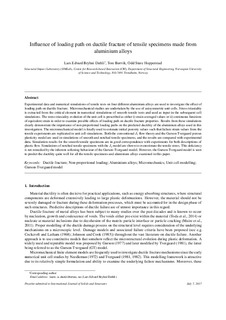| dc.contributor.author | Dæhli, Lars Edvard | |
| dc.contributor.author | Børvik, Tore | |
| dc.contributor.author | Hopperstad, Odd Sture | |
| dc.date.accessioned | 2017-10-16T13:35:40Z | |
| dc.date.available | 2017-10-16T13:35:40Z | |
| dc.date.created | 2016-06-20T09:21:06Z | |
| dc.date.issued | 2016 | |
| dc.identifier.citation | International Journal of Solids and Structures. 2016, 88-89 17-34. | nb_NO |
| dc.identifier.issn | 0020-7683 | |
| dc.identifier.uri | http://hdl.handle.net/11250/2460359 | |
| dc.description.abstract | Experimental data and numerical simulations of smooth and notched tensile tests on four different aluminium alloys are used to investigate the effect of loading path on ductile fracture. Micromechanical studies are undertaken by the use of axisymmetric unit cells. Stress triaxiality is extracted from the critical element in numerical simulations of smooth tensile tests and used as input in the subsequent unit cell simulations. The stress triaxiality evolution of the unit cell is prescribed as either (i) strain-averaged values or (ii) continuous functions of equivalent strain in order to examine possible effects of loading path on ductile fracture properties. Results from these simulations clearly demonstrate the importance of non-proportional loading paths on the predicted ductility of the aluminium alloys used in this investigation. The micromechanical model is finally used to estimate initial porosity values such that coalescence strain values obtained from simulations of the smooth tensile specimens are recaptured in the unit cell simulations. Both the conventional J2 flow theory and the Gurson–Tvergaard porous plasticity model are used in simulations of smooth and notched tensile specimens, and the numerical results are compared with experimental data. Simulation results for the smooth tensile specimens conform to experiments for both descriptions of plastic flow. Simulations of notched tensile specimens with the J2 model are shown to overestimate the tensile stress. This deficiency is not remedied by the inherent softening behavior of the Gurson–Tvergaard model. However, the Gurson–Tvergaard model is seen to predict the ductility quite well for smooth and notched specimens of all aluminium alloys examined in this paper. | nb_NO |
| dc.language.iso | eng | nb_NO |
| dc.publisher | Elsevier | nb_NO |
| dc.rights | Attribution-NonCommercial-NoDerivatives 4.0 Internasjonal | * |
| dc.rights.uri | http://creativecommons.org/licenses/by-nc-nd/4.0/deed.no | * |
| dc.title | Influence of loading path on ductile fracture of tensile specimens made from aluminium alloys | nb_NO |
| dc.type | Journal article | nb_NO |
| dc.type | Peer reviewed | nb_NO |
| dc.description.version | acceptedVersion | nb_NO |
| dc.source.pagenumber | 17-34 | nb_NO |
| dc.source.volume | 88-89 | nb_NO |
| dc.source.journal | International Journal of Solids and Structures | nb_NO |
| dc.identifier.doi | 10.1016/j.ijsolstr.2016.03.028 | |
| dc.identifier.cristin | 1362420 | |
| dc.relation.project | Norges forskningsråd: 237885 | nb_NO |
| dc.description.localcode | © 2016. This is the authors’ accepted and refereed manuscript to the article. LOCKED until 1.4.2018 due to copyright restrictions. This manuscript version is made available under the CC-BY-NC-ND 4.0 license http://creativecommons.org/licenses/by-nc-nd/4.0/ | nb_NO |
| cristin.unitcode | 194,64,45,0 | |
| cristin.unitname | Institutt for konstruksjonsteknikk | |
| cristin.ispublished | true | |
| cristin.fulltext | postprint | |
| cristin.qualitycode | 1 | |

